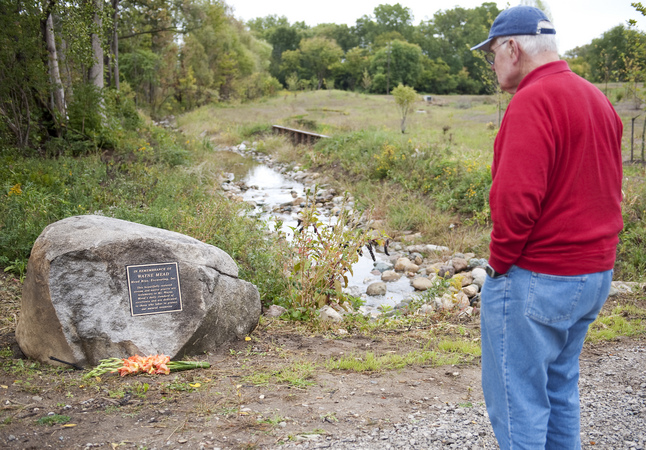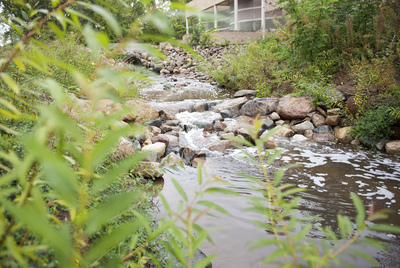Completed Malletts Creek project restores habitat, fights erosion, officials say

An Ann Arbor resident looks at the plaque honoring Wayne Mead, who died working on the Malletts Creek restoration project.
Daniel Brenner | AnnArbor.com
The goal was to improve water quality and habitat while maintaining safe, stable drainage through the creek basin.
Embankments that were once steep — causing a narrow, fast flow in the drain that swept sediment straight into the Huron River — are now more gradual.

A restored section of the creek.
Daniel Brenner | AnnArbor.com
Sections of the drain have been bolstered with rock, and diversions have been created to prevent further erosion of embankments.
A native seed mix has been spread across the restored area at the County Park adjacent to Washtenaw Avenue to create a wetland.
"We stabilized 9,000 feet of stream channel using natural approaches that will be sustainable in an urban environment," Drain Commissioner Janis Bobrin told about three dozen people who gathered at the park's administrative building Saturday afternoon for the grand opening.
Malletts Creek is located both in the City of Ann Arbor and Pittsfield Township. The watershed is 11-square miles in area and flows into the Huron River. Malletts Creek drain is the main outlet for storm water runoff from the city of Ann Arbor.
Bobrin completed the restoration's master plan in the spring of 2000.
"Its many elements included changes in development standards and other regulations, public education, and the physical restoration of the stream itself," Bobrin said.
Bobrin also said the project created the best possible habitat, and reduced stream bank erosion from 913 to 72 tons per year, which will result in an annual reduction of 715 pounds of phosphorus that was being discharged to the Huron River from the Malletts Creekshed.
"It feels good to start seeing the differences made like phosphorus reduction, more storm water control and less erratic flow," said Harry Sheehan, Bobrin's environmental manager.
The $2.7 million dollar environmental project, which was funded by a grant from the Department of Environmental Quality and a revolving loan from the state, was fraught with problems along the way including an accident that left an employee of Mead Bros. Excavating dead.
Saturday, Bobrin along with Bob Tetens, Washtenaw County Parks and Recreation director, paid tribute to Wayne Mead, who was pinned by an excavator while working on the restoration. Alarge rock with a plaque at the park's northern entrance off Washtenaw Avenue reads: "This beautifully restored stream and native prairie are testaments to Mr. Wayne Mead's daily standard of excellence and are dedicated to those who labor to protect our natural resources."
The project came to fruition thanks to the combined effort of the City of Ann Arbor, Pittsfield Township, the Huron River Watershed Council, the Malletts Creek Association, the residents of the Malletts Creek basin, and the Michigan DEQ.
Lisa Carolin is a freelance reporter for AnnArbor.com. To reach the news desk email news@annarbor.com or call 734-623-2530.


Comments
Epengar
Mon, Sep 24, 2012 : 3:04 a.m.
I hope Brad and Runs With Scissors can be patient. I think that next year the vegetation will really get going. The drought this summer slowed down growth tremendously. Next spring will see a big change. Obviously that stretch is going to be open for years to come, but the diverse plant community will look good, and the wet meadow will have lots of native wildflowers and the butterflies they attract. Most of the tree removal was due to the construction, not because they were non-natives. The big invasive, honeysuckle, is a large shrub. Honeysuckle has fragrant blossoms, and birds can eat its berries in the fall, but none of our local insect species can eat the plant itself. That means that in the spring and summer honeysuckle thickets are "green deserts" -- nothing can find food there. Even seed-eating birds need to feed their young insects (they need the protein), but they can't get any from honeysuckle thickets. Finally, keep in mind that the ecological restoration is just gravy. The meat of this project is managing storm water flows. In the last 10 years or so, several independent science and engineering studies have found that the Midwest has been getting more heavy downpours per year, and this trend has been increasing since the 70's or earlier. Not that we are necessarily getting more rainfall total per year, but that the rain we do get falls in more heavy downpours and fewer gentle showers. It's important that we have the infrastructure to handle these heavy rains.
Scott Spooner
Mon, Sep 24, 2012 : 11:02 a.m.
Very well said! Seeing the lack of woody plants and thinking this project was "destruction" is short-sighted and myopic.
RunsWithScissors
Sun, Sep 23, 2012 : 8:12 p.m.
The initial impact of this project is a helluva eyesore. I used to love wandering through all of County Farm Park but now avoid this area. The wholesale destruction, in my opinion, was not worth the improved drainage. This park was a jewel. A place to get away from noisy cars, endless pavement and to pretend that I'm miles away from a busy city. I fear that more "improvements" will be made to other sections of the park. Is this what the original designer of the park had in mind?
Brad
Sun, Sep 23, 2012 : 4:32 p.m.
Hopefully someday the new foliage they planted will again serve as a barrier to seeing and hearing the traffic on Washtenaw while you're in the woods and park, but that sure isn't the case today. Those non-native species were doing a fine job of that. I hope it was all worth it.
Kai Petainen
Sun, Sep 23, 2012 : 2:34 p.m.
This is a mix of great news and sad news.... It's fantastic that this has been completed. Kudos to Bobrin and others... Sad about Mead...
OLDTIMER3
Sun, Sep 23, 2012 : 1:26 p.m.
What a shame Wayne had to die during this project. Maybe this plaque will help ease the families pain. I am sure Wayne is looking down on this completed project and smiling now that is completed.RIP